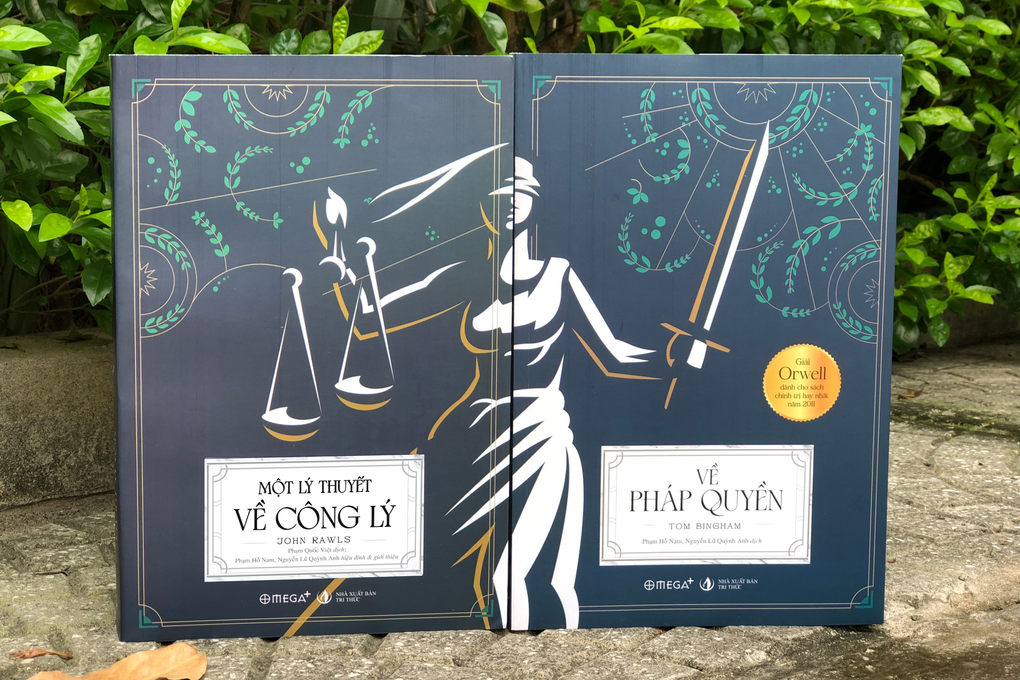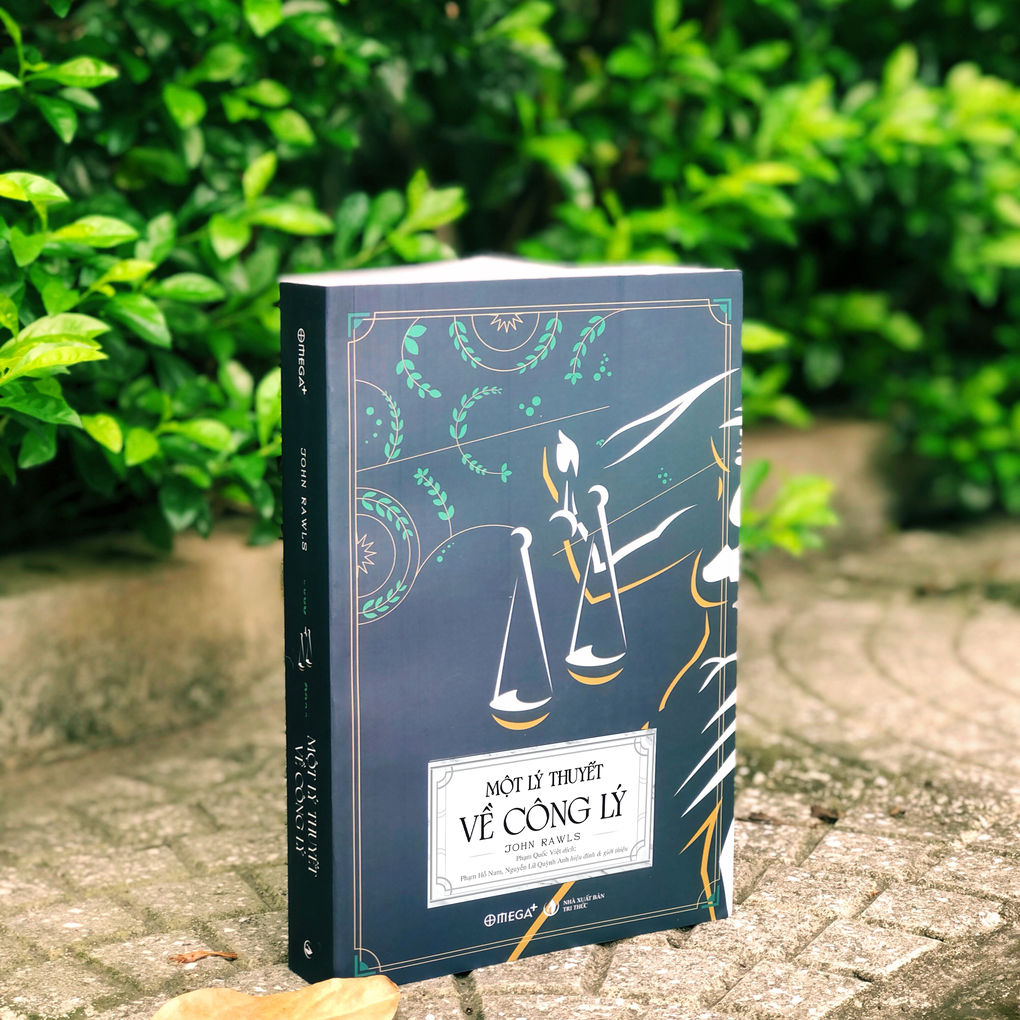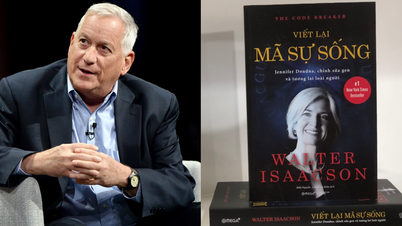Omega Plus publishes a classic series of legal books, including On the Rule of Law by Tom Bingham and A Theory of Justice by John Rawls.
If On the Rule of Law is the first book on the market to provide readers with the most complete and easily accessible information about the rule of law, then A Theory of Justice is a classic book that provides a detailed look at the issue of justice, with far-reaching influence.
Omega Plus explains the cover design of the series. When the two books are placed side by side, the reader will see the complete image of Lady Justice.

Unique book cover design when placing two books side by side (Photo: Omega Plus).
In A Theory of Justice , the image of the scales represents fairness and the law's duty to weigh the evidence presented in court. Each side of a legal case needs to be considered and compared in order to achieve justice.
In On the Rule of Law , the sword symbolizes the enforcement and supremacy of the law, and also means that justice stands before its decisions and verdicts.
The law measures justice for the people but needs a sword to protect it. Therefore, the sword being drawn from its sheath is a sign that justice is transparent, not an instrument of fear.
"The completed collage with the image of the Goddess of Justice blindfolded, holding a sword in her right hand and a scale in her left hand creates a harmonious work of art. This design represents the perfection in exploring and understanding justice and the rule of law in modern society," said the representative of the publishing unit.
"On the rule of law"
In On the Rule of Law – winner of the 2011 Orwell Prize for best political book – Tom Bingham, one of the world's sharpest legal minds, discusses the formation and meaning of the rule of law.
According to him, the rule of law is not a dry theory, but the real foundation of a just society.
It is also the guarantee of a responsible government that makes an important contribution to economic development, while ensuring peace and cooperation between nations.
The book presents a brief history of the rule of law, eight basic elements that summarize the essence of the concept, and discusses tensions, through three main parts.
Part 1: Discuss the importance of the rule of law and some important milestones in the development of the rule of law.
Part 2: Discusses the eight basic elements that summarize the nature of the rule of law.
Part 3: Discusses tensions with the rule of law.
The Guardian reviews the book as a remarkable essay on the subject, moving from the broad to the brief but detailed case studies based on cases in which the author himself was involved.
The Independent called On the Rule of Law "a timely and inspiring gem", recommending it to everyone.
Tom Bingham (1933-2010) was the only person to have held three positions: Head of the Civil Division of the Court of Appeal for England and Wales; Chief Justice of the Royal Courts of Justice for England and Wales; and Lord High Commissioner for Legal Affairs of the United Kingdom.
After retiring in 2008, he focused on teaching, writing and lecturing on legal topics, especially human rights law.
The Bingham Centre for the Rule of Law in the UK is named after him.
"A Theory of Justice"
John Rawls—who is considered one of the most influential political philosophers of the twentieth century—provided an ethical framework for evaluating and improving the basic structures of society in A Theory of Justice .
The book is Rawls's attempt to address the issue of fairness in the allocation of resources in society, as an alternative to the traditional philosophy of utilitarianism (which holds that society should pursue the greatest good for the greatest number).
The core idea of the work is "justice as fairness", which is based on the equal liberty of rational individuals in a social order that aspires to achieve equality of opportunity and distribution of benefits to all, especially the most disadvantaged.

Cover of the book "A Theory of Justice" (Photo: Omega Plus).
The work is divided into 3 parts:
Part 1: Theory, including chapters: Justice as fairness; Principles of justice; Original position.
Part 2: Institutions, including chapters: Liberty and Equality; Distribution; Duties and Obligations.
Part 3: The Ends, including the chapters: The Good as Reason; The Sense of Justice; The Good of Justice.
Bordley Rawls (1921-2002) was an American moral and political philosopher and professor at Harvard University. He won the Schock Prize in Logic and Philosophy and was awarded the National Humanities Medal by President Bill Clinton in 1999.
He is famous for his research on liberal political philosophy with many remarkable ideas.
In addition to A Theory of Justice (1971), he is the author of two other books: Political Liberalism (1993) and The Law of Peoples (1999).
Source link






![[Photo] 60th Anniversary of the Founding of the Vietnam Association of Photographic Artists](/_next/image?url=https%3A%2F%2Fvphoto.vietnam.vn%2Fthumb%2F1200x675%2Fvietnam%2Fresource%2FIMAGE%2F2025%2F12%2F05%2F1764935864512_a1-bnd-0841-9740-jpg.webp&w=3840&q=75)
![[Photo] National Assembly Chairman Tran Thanh Man attends the VinFuture 2025 Award Ceremony](/_next/image?url=https%3A%2F%2Fvphoto.vietnam.vn%2Fthumb%2F1200x675%2Fvietnam%2Fresource%2FIMAGE%2F2025%2F12%2F05%2F1764951162416_2628509768338816493-6995-jpg.webp&w=3840&q=75)































































































Comment (0)